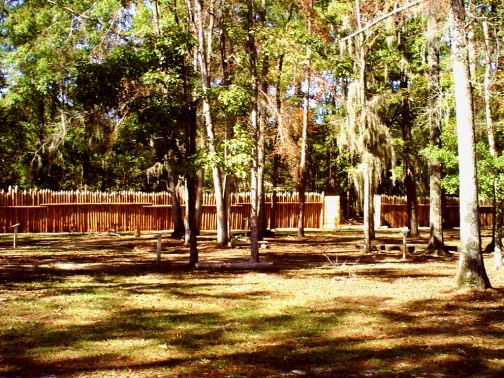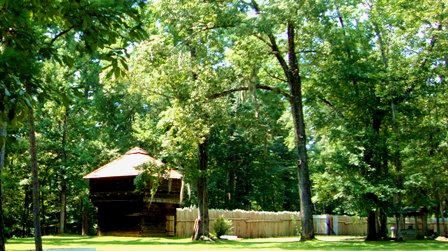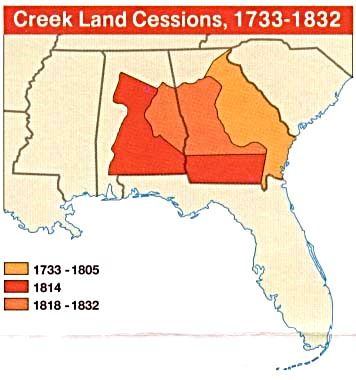Fort Mims Massacre
By Gary Wright

“Do not confuse ‘duty’ with what other people expect of you.”
—Robert A. Heinlein, ‘Time Enough for Love’
A long time ago, in a place that is rather close geographically, but far removed in culture and way of life, a war party of some 2,000 hostile Creek Indians overwhelmed Fort Mims, Alabama and massacred over 500 men, women, and children. Fort Mims stood on a piece of high ground along the Tensaw Lake, some 35 miles north of Mobile. It was a natural place for the settlers in the area to gather and strengthen the buildings which existed on the farm of Samuel Mims.
In the years following the American Revolution, the area in what is now Georgia, Florida, and Alabama was a hot bed of conspiracy, connivery, and murder involving Spain, France, England, and the newly formed and out-classed United States. Each country was trying to gain the upper hand on the others, using any means available, in order to secure trade with the Creeks and take control over their territory. The hapless Creek Indians were used by all parties. A group of ‘Red Stick’ warriors led by William Weatherford, also known by his native name of Red Eagle, was especially easy to stir up by the English against the American settlers in the area. Just after sunrise on August 30, 1813, the ‘Red Sticks’ attacked the unprepared and unsuspecting fort with their force of revenge-thirsty, battle-ready warriors.
The defenders couldn’t get the front gate closed due to accumulated dirt, thus allowing the Indians to pour in and quickly overwhelm the soldiers. The ‘Red Sticks’ now turned their attention on the helpless women and children, murdering, raping, and brutalizing the survivors. The death toll of the defenders was around 550, while the Indians lost less than 200, making it the deadliest massacre of Indians against whites in U.S. history.

The massacre sent terror through the hearts of the whites throughout the southeast, especially residents of nearby Mobile, and made headlines all over the nation. The whites adopted a phrase still in use today to acknowledge uncertainty in everyday life—“If the Lord’s willing and the Creeks don’t rise.” Though the ‘Red Sticks’ could have made general warfare on the whites all over Alabama, Florida, and Georgia, they chose to do little to follow up their bloody attack. They mostly waited for what everyone knew would be retribution. This inaction trumpeted the thought that they knew they had made a strategic mistake.
The event attracted attention from a little-known Indian-hater in Tennessee who had been looking for a cause such as this to propel him into the national lime-light. General Andrew Jackson, commander of the Tennessee Department of the U.S. Army, quickly gathered a force of volunteers and militia to complement his meager force of regulars. He moved south and enlisted Cherokees, Choctaws, and even some friendly Creeks. Avenging the Fort Mims massacre with his own, he massacred Creek men, women, and children at the battle of Horseshoe Bend, Alabama.
Within a year he had broken the ‘Red Stick’ uprising. With his name in headlines, Andy Jackson marched on to New Orleans, where he decisively defeated the British with his now veteran army and with the help of backwoodsmen, settlers, sailors, and a Cajun pirate named Jean Lafitte.
General Jackson, whose Indian-hating would become obvious with the removal of the friendly Cherokee to Oklahoma, used the massacre at Fort Mims to further his own personal ambitions, and went on to become one of the most famous and most controversial Presidents in American History. His infamous order of removal of all Indians east of the Mississippi River to the inhospitable Oklahoma Territory, was declared null and void by the U.S. Supreme Court. However, he simply ignored that ruling and forcibly used the U.S. Army to kidnap Indian men, women, and children, and moved them via the ‘Trail of Tears,’ where thousands died of starvation, neglect, and abuse.
He avenged the Fort Mims massacre, but his excessive force and hatred of Native Americans still taints his memory and legacy. In a lot of places in Oklahoma that mark the end of the ‘Trail of Tears,’ many Native Americans still refuse to accept or use the U.S. twenty-dollar bill as legal tender, because it bears the portrait of Andrew Jackson, the hero of the Battle of New Orleans and the villain of the ‘Trail of Tears.’ Where hate and violence is sown in anger, it will always be reaped in vengeful abundance.

(To return to the HOME PAGE click on the icon in top left-hand corner of this post)
Photo of the west wall of Fort Mims licensed under CC By 4.0 — linked to commons.wikimedia.org
Photo of Fort Mims licensed under CC By 4.0 — linked to preserveala.org
Map of Creek land sessions is licensed under CC By 4.0 — linked to en.wikipedia.org



Deborah, you have made Porchscene my favorite go to for anything “southern”. Like Jimmy, I too thought the creek” ( I always used the singular version) meant a stream of water. This article is so informative about Andrew Jackson. When you know the truth, it is harder to hold him in high esteem. I think about the Indians often concerning Trail Of Tears. Heartbreaking.
***By the way, on my way to Orange Beach on Sunday, our last put stop was a roadside market with vine ripe tomatoes and BOILED PEANUTS!!!! They had five huge vats simmering in brine in front of the entrance. They were huge and delish!!!
Thanks for your encouraging words about the blog, Yancey. Always good to hear!
I didn’t know that you could freeze the boiled peanuts, so now that I do, I have some anytime I want them!
I always thought that the expression ” the creek don’t rise” was referring to floodwaters. thanks for correcting my misinterpretation.
I did too, Jimmy! See what can be learned by reading Porchscene!! 🙂